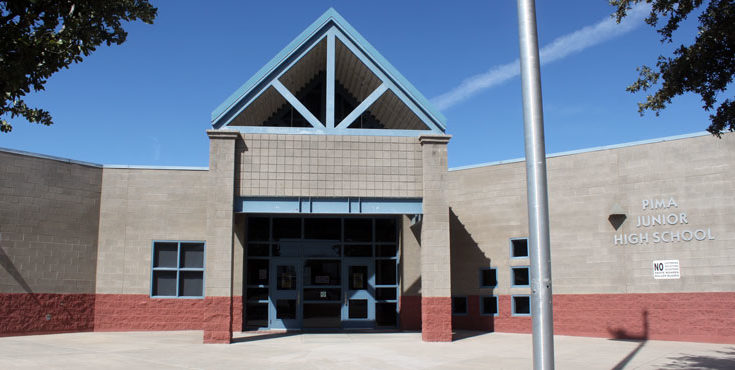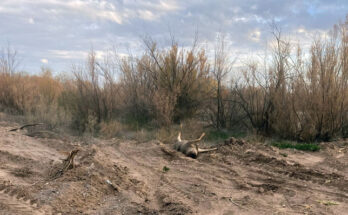Jon Johnson File Photo/Gila Herald: The Graham County Department of Health and Human Services will hold its final day of a special COVID-19 testing clinic at Pima Junior High on Friday, from 9 a.m. – 3 p.m. So far, the clinic has tested four students who were symptomatic for the virus but tests have yet to come back from the state laboratory.
“We’re not stopping this virus, we’re just slowing it down.”
Graham County Health Department Director Brian Douglas
By Jon Johnson
PIMA – A total of four students who attend the Pima School District have been tested for the novel coronavirus COVID-19 in two days of a special clinic at Pima Junior High. However, test results are not expected back until Saturday due to a large number of tests being analyzed by the Arizona State Public Health Laboratory.
As of early Thursday morning, the confirmed and the presumptive number of cases of COVID-19 in Arizona stood at 44; Maricopa County – 22, Pinal County – 10, Pima County – seven, Navajo County – three, Coconino County – one, and Graham County – one.
The state lab has the capacity to test up to 450 people each day, and, according to Graham County Health Department Director Brian Douglas, there is an influx of thousands of specimens statewide awaiting analysis.
“They’re just overwhelmed,” Douglas said.
Safford Mayor Jason Kouts was also tested for COVID-19 by his healthcare provider on Saturday after falling ill and his test reportedly was sent out for analysis on Monday. The results of his test are yet to be known as well.
Douglas advised that they should know more about the spread of the disease into Graham County after the tests come back.
“That might be indicative of whether the spread is still considered close contact with Pima or if it spread beyond that,” Douglas said.
The mobile clinic was set up after an elementary staff member who works with fifth and sixth graders had a positive test. The school district was closed Thursday, March 12, making the last day the staff member of having any interaction with a student as of March 11. With an incubation period between 2-14 days, the health department requested parents quarantine Pima students until March 25. After this, any student who contracted the disease should have shown symptoms and if they were asymptomatic the disease should have run its course by then, according to Douglas.
The testing clinic will have its final day Friday, from 9 a.m. – 3 p.m. at the Pima Junior High for students who are now experiencing symptoms of COVID-19, including a persistent cough, fever, body aches, and difficulty breathing.
“It will give those who were potentially exposed more time to be symptomatic,” Douglas said. “That’s why we scheduled one later in the week.”
While students may be cleared from their possible exposure with the school staff member after March 25, they should still practice recommended health protocol, including social distancing.
“We’re not stopping this virus, we’re just slowing it down,” Douglas said. “It’s definitely out in the public.”
Graham County’s response has been quick after its lone positive test and Douglas attributes the reaction to the past creation of private and public sector relationships.
“It’s amazing how everyone pulled together so quickly so well,” he said.
General things that everyone should do to prevent the spread of all respiratory illnesses
- ● Avoid close contact with people who are sick.
- ● Avoid touching your eyes, nose, and mouth.
- ● Stay home when you are sick.
- ● Cover your cough or sneeze with a tissue, then throw the tissue in the trash.
- ● Clean and disinfect frequently touched objects and surfaces using a regular EPA registered household cleaning spray or wipes.
- ● Wash your hands often with soap and water for at least 20 seconds. If soap and water are not readily available, use an alcohol-based hand sanitizer.
What you need to know about COVID-19
- ● COVID-19 causes a wide range of symptoms including fever, cough, and difficulty breathing.
- ● Most people (about 80%) develop only mild symptoms, particularly children.
- ● Like influenza, those most likely to develop a severe disease are people older than 60 years and those with other medical conditions like heart or lung disease.
- ● The virus is spread person-to-person via respiratory droplets produced when an infected person coughs or sneezes.
- ● People who are most at risk of becoming infected are those who have prolonged, close contact with a person who is infected with COVID-19 and is symptomatic.
- ● There is currently no vaccine or treatment for COVID-19.
- ● Find up to date information at azhealth.gov/COVID-19 and at https://www.cdc.gov/coronavirus/2019-ncov/index.html.









